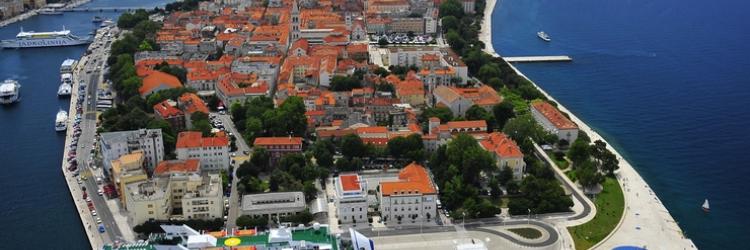Travel destinations Comments: 0 May 29, 2017
Located in Croatia, Zadar with its historic old town dating from the Roman period, mixture of medieval churches and modern cafes and versatile museums set on a small peninsula, is one of the favorite travel destinations and a must when going through the Balkans. Eve though it is rather sunny throughout the year, the number of tourists doesn’t amount to that of Dubrovnik, so it might be a perfect place for those who enjoy more relaxed atmosplhere, achieved by its two unique attractions – the sound-and-light spectacle of the Sea Organ and the Sun Salutation – that need to be seen and heard in order to be believed. Zadar may not be a kind of place you see on postcards, but it will captivate you with its mix of ancient relics, Habsburg elegance, coastal region and mesmerising tower blocksthat make Zadar what it really is - a living, vibrant city, enjoyed by residents and visitors alike.
Zadar’s incredible Sea Organ, designed by local architect Nikola Bašić, is one of its kind. Set within the perforated stone stairs that descend into the sea is a system of pipes and whistles that exudes wistful sighs when the movement of the sea pushes air through it. The effect is hypnotic, the mellifluous tones increasing in volume when a boat or ferry passes by. You can swim from the steps off the promenade while listening to the sounds.
Sun Salutation: Another unique and wonderful creation by Nikola Bašić (along with the nearby Sea Organ), this 22m-wide circle set into the pavement is filled with 300 multilayered glass plates that collect the sun’s energy during the day. Together with the wave energy that makes the Sea Organ’s sound, it creates a light show from sunset to sunrise that’s meant to simulate the solar system. Besides its visual attractiveness, it also accumulates enough energy to power the entire harbour-front lighting system.
Roman Forum: One of the most intriguing things about Zadar is the way Roman ruins seem to pop out randomly from the city's streets. There is no other place in the world where this is more prominent than at the site of the ancient Forum, constructed between the 1st century BC and the 3rd century AD. As in Roman times it's still the centre of civic and religious life, with St Donatus' Church dominating one side of it.
St. Donatus’ Church: Dating from the beginning of the 9th century, this unusual circular Byzantine-style church was named after the bishop who commissioned it. Having survived the Mongol invasion of the 13th century, it's one of only a handful of buildings from the early Croatian kingdom of grand historical importance for the city. The simple and unadorned interior includes two complete Roman columns, recycled from the Forum. The Forum also gave the substance for the paving slabs that were revealed after the original floor was removed.
Museum of Ancient Glass: Despite the fact that Zadar has been affected by numerous earthquakes and multiple wars over the years, this impressive and rather delicate museum still stands proudly and has thousands of objects to exibit: goblets, jars, vials, jewellery and amulets. Many of the larger glass urns were removed from the local Roman necropolis (cemetery) where they held cremated remains. The layout is superb, with large light boxes and ethereal music to heighten the experience.
St. Anstasia’s Cathedral: Built between the 12th and 13th centuries, Zadar's cathedral has a richly decorated facade and an impressive three-nave interior with the remains of frescoes in the side apses. The cathedral was badly damaged during WWII and has since been reconstructed. On the altar in the left apse is a marble sarcophagus containing the relics of St Anastasia, while the choir contains lavishly carved stalls. A glass vestibule allows you to peer inside when the cathedral's closed.
People’s Square: Traditionally the centre of public life, this pretty little square is constantly buzzing with the chatter from its many cafe-bars. The western side is dominated by the late-Renaissance City Guard building, dating from 1562; the clock tower was added under the Austrian administration in 1798. Public proclamations and judgments were announced from the loggia opposite (1565), which is now an art-exhibition space.
Archeological Museum: A wealth of prehistoric, ancient and medieval relics, mainly from Zadar and its surrounds, awaits at this fascinating museum. Highlights include a 2.5m-high marble statue of Augustus from the 1st century AD, and a model of the Forum as it once looked.
Franciscan Monastery: Entry to this historic monastery includes access to a lovely Renaissance cloister, the Gothic church (the oldest of its kind in Dalmatia, consecrated in 1280), the sacristy (where the 1358 treaty under which Venice relinquished its rights to Dalmatia in favour of the Croatian-Hungarian king Ludovic was signed) and a small treasury. Highlights of the last include a large 12th-century painted wooden crucifix, a 15th-century polyptych from the island of Ugljan and a 16th-century painting of the dead Christ by Jacopo Bassano.
Five Wells Square: Built in 1574 on the site of a former moat, this square takes its name from the five wells that supplied Zadar with water until 1838. Set into the neighbouring bastion is Queen Jelena Madijevka Park, a lovely little garden with shady paths, a cafe and views from the ramparts.
Land Gate: The most elaborate of the city gates also has the prettiest setting, facing a sheltered little marina. Dating from 1543, its Renaissance-style decorations include St Chrysogonus (Zadar's patron saint) on horseback and the Venetian winged lion. The gate is still used by traffic.
Sea Gate: Also known as St Chrysogonus' Gate (Vrata Sv Krševana), this port-facing archway was built in 1573 and sports the Venetian lion and part of a Roman triumphal arch. The inscription is a memorial to the 1571 Battle of Lepanto, where the Ottoman fleet was defeated off western Greece.
The city of Zadar is an easily reached destination by land, sea and air. It has a good traffic infrastructure through which it is directly connected to other bigger cities of the Republic of Croatia: Zagreb, Rijeka, Split and Dubrovnik, with extraordinary accommodation and contemporary service of numerous marinas. Whichever way you want to reach Zadar, the natural beauty of the landscape will not leave youindifferent.
The ferry port as well as the new tourist port for cruisers are located on the new and spacious Gaženica port, some 3 km away from the center of the town (tourist cruising ships as well as local ferry and ship lines with Preko, Zaglav, Mali Lošinj, Pula and Ancona/Italy).
Air transport, even though the airport is small it is contemporary (9 km distance from the center), and connects Zadar with bigger cities of the Republic of Croatia and some European capitals. Other destinations are accessible with changes in Zagreb, the capital of the Republic of Croatia and in the network of international air traffic (London-Stansted, Paris-Beauvais, Berlin, Stockholm, Bruxelles-Charleroi, Marseille, Frankfurt, Munich, Hamburg, Zürich, Oslo-Rygge, Dublin, Manchester, Düsseldorf, Karlsruhe, Göteborg, Billund, Wroclaw, Haugesund, Cologne/Bonn, Stuttgart, Bratislava, Friedrichshafen, Warsaw and Gdansk).
Situated in the heart of the Adriatic, Zadar is the urban center of northern Dalmatia as administrative, economic, cultural and political center of the region with 75,000 inhabitants. The coast is particularly indented, the islands and the untouched nature allures many boaters to this regions. The archipelago counts 24 bigger and about 300 smaller islets and rocks, 3 nature parks - Telašćica, Velebit and Vransko lake and 5 national parks - Paklenica, Plitvice lakes, Kornati Islands, Krka and Northern Velebit classifying Zadar and its surroundings at the very top of the Croatian tourist offer.


 RS
RS  ME
ME  HR
HR  BA
BA  RU
RU  MK
MK  AL
AL  ES
ES  DE
DE  IT
IT  CN
CN  NL
NL  SE
SE  FR
FR 






Write a comment